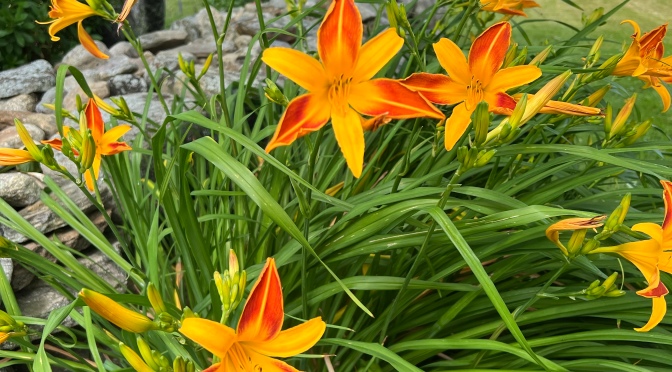.
It’s daylily time.
.

.
When we bought this house there were no gardens to speak of and very little in the way of plantings but there were two bunches of oranges daylilies .
.

.
I can’t honestly say that’s where I would have planted them, but they thrive so who am I to complain?
.

.
Orange seems to be the hardiest and most prolific color in my part of the world.
.

.
And honestly they’re the easiest no fuss, no care flower there is.
.

.
I’ve planted a few others over the years….
.

.
But it really is a shame they’re true to their name. Each bloom only lasts a day.
.


I love day lily season.
LikeLiked by 1 person
One of my favourite perennials! So lovely! So little work 😉 for such a big payoff.
Deb
LikeLiked by 1 person
Our daylilies took a beating this year from some necessary pruning of out walnut tree. Bee balm too. I expect to see them return next year.
LikeLiked by 1 person
They’re indestructible. We had to dig up our water pump under one a few years ago and it came back.
LikeLike
They are welcome guests to the party, even if they aren’t staying very long.
LikeLiked by 1 person
Our orange lil8es are certainly not day lilies. I don’t know how long they actually last, because there are so many of them. I guess they are a form of tiger lily as the petals have some brown in them, though not much. They grow on their own, though I transplated them from where there were growing wild into a flower garden many years ago and they took a while to get used to their new home. And how they have expanded. I trabsplated about 40 bulbs and now there are close to 100 plants. The awesome thing is, each plant grows about 10 to 14 flowers, so we get over 1000 flowers in the course of about 6 or 7 weeks. The flowers never open all at the same time, so there is a neverending sea of orange from late June through July and into August. What a beautiful sight!
LikeLiked by 1 person
Wow, that sounds wonderful!
LikeLike
When we moved into our home in spring of 2007, there was an elm tree and a (Russian?) olive sticking up out of three feet of snow. We had no idea at all what was there. When the snow melted I started trying to tame the lawn. But there were areas that would not be tamed. So we filled in spaces with dogwoods, an amur maple, spruces, a cedar, and a black elm. In the front yard there was a (Hungarian?) lilac bush. The first thing we added there was a willow. It was supposed to grow no larger than 4 feet high and 4 feet wide. By sheer luck we put it in the best place possible. In two years it was 6-7 feet high, and just as round. Then I added lilac seeds from the original bush, and a few other varieties. I coddled them for years. The ones planted by the willow now stand 10 feet tall. Of the ones that survived (about 40%) they range from 18 inches to 4 feet high. Some spots seem to have good growing soil while others are barely growing up at all. I cannot explain why they are so different.
But back to the back yard. As the 1st summer progressed some plants refused to be tamed. When I finally let them grow at last (read when I gave up trying to mow them down) I learned they were not weeds, but in one spot lilies (as described above) and a few baby maples. But the maples grew too fast to be trees, and they spread wide. They are now maple bushes reaching about 8 feet high (so far) and the leaves turn crimson in the fall. They stretch from the elm to the olive, and in autumn the back yard becomes almost a forest. The weirdst thing, the olive, which stood about 15 feet a few years ago, suffered badly one winter, and the top died, But, it is very alive, and now has become a bushy tree, short (only 8′) but very wide. And just a few weeks ago I noticed another maple bush is growing on the opposite side of the olive, so in the next few years we will have a stretch about 50′ wide of elm, maple, olive, and maple again. It is already one of the most beautiful stretches of tree growth in town, and it is getting better by the year. The trees we planted around the edges of the yard, after 15 years, are only now gaining some height, the growing conditions are obviously hard. But that stretch at the very back of the yard seems to have perfect conditions, because everything there, including the lilies, is flourishing. If I knew how to add pictures to comments I would show you, but so far that seems impossible.
LikeLiked by 1 person
It is impossible, but you could always write a blog post about it. Sounds lovely.
In Maine, Russian olives are an invasive species we rip up when they sprout. They grow rapidly and choke out everything else. You’re lucky to have good soil. Our backyard is mostly clay and we have a helluva time getting anything to take.
LikeLike
Six inches below the soil is at least 4 feet of clay, in some areas. I dried to dig through it when planting the trees, and never got out of it. But at the back of the yard, there is no clay. I think, in fact, there is an underground stream that goes under that part because everything grows so well.
The front yard is hit and miss, it seems. The willow and the lilacs beside it thrive, while everything else struggles. The original lilac bush that was here when we moved in has grown MAYBE 6 inches in 15 years. I thought it was just natural, until the seeds from it that I planted near the willow shot up. The rest languished, or died.
Growing up in Winnipeg, which is mostly “Clay City” taught me about growing in clay.
LikeLiked by 1 person
The Iris family is very hardy. If you want to change the color, change the Ph acid level in the soil and wait a couple of seasons. I have read that adding metallic Nickle to the soil works, but have never really tried it. In Florida, bulbs still hibernate in the winter, and we prefer year round blossoms.
LikeLiked by 1 person
That’s what those are!! When I bought my house, I found some on the side the house not knowing what they were. Then they bloomed and I have white day-lilies and they are white with a pink center.
LikeLiked by 1 person
Wow. I’ve never seen white….
LikeLiked by 1 person
Well I could be wrong, I didn’t even know what they were until this post. But they sure look similar.
LikeLiked by 1 person
They are lovely!
I was TODAY years old when I learned they only lived one day. *slaps hands to face*
We don’t have them way down here….so that’s my excuse, and I’m going to stick to it.
LikeLiked by 1 person
Day. Lilies.
The name says it all.
😉
LikeLiked by 1 person
🫣🥴
LikeLike
They’re very common in Minnesota, too. Overused, actually, in my opinion, but they’re so easy I can see why. I always go through the trouble of removing the spent bloom. I wish it would reward me with new blooms for my efforts like the nice plants do.
LikeLiked by 1 person
I’m not clever enough to have rotating perennial garden blooms which is why I always buy annuals to fill in.
LikeLiked by 1 person